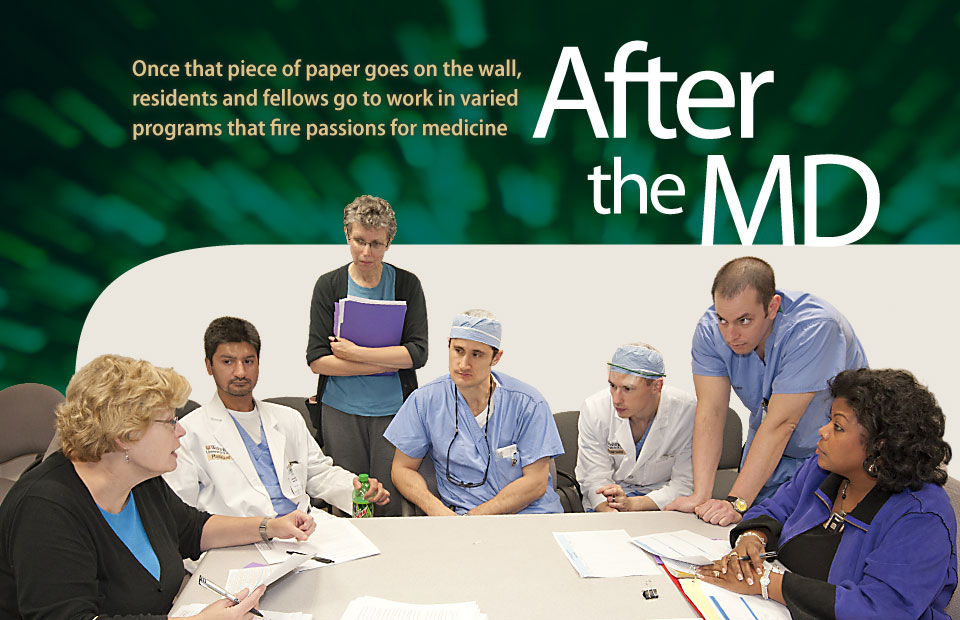
BY HOLLY EDMISTON
MEDICAL SCHOOL MAY TEACH THE BASICS, but it is postgraduate education that truly prepares young physicians to independently practice medicine. The Accreditation Council for Graduate Medical Education (ACGME) is the main accrediting body for U.S. residency and fellowship programs. At Washington University School of Medicine, the Office of the Associate Dean for Graduate Medical Education (GME) maintains oversight of accreditation for all postgraduate clinical training.
That effort is headed by Rebecca P. McAlister, MD, professor of obstetrics and gynecology and associate dean for graduate medical education, and Tia O. Drake, director, graduate medical education.
“The job of the ACGME and our office is to ensure that our programs meet established standards,” says McAlister. “We ensure that we maintain a quality educational environment for all upper-level trainees in any of the residency and clinical fellowship training programs at the university or our affiliated hospitals.”
The GME office heads the Washington University Barnes-Jewish Hospital St. Louis Children's Hospital Educational Consortium. Postgraduate trainees can be employed at any of the three institutions, but the oversight for the educational environment resides with the GME office, while the hospitals focus on patient care and the physical environment.
“Our primary goal is to ensure that the people we turn out at the end of their training are competent in an array of areas,” says Drake. "These include their medical knowledge, their professionalism, and their ability to communicate."
Rebecca P. McAlister, MD, far left, and Tia O. Drake, far right, meet regularly with residents, fellows and their program directors to discuss issues related to postgraduate clinical training.
Enjae Jung, MD, in the OR.
A bond of trust
Fourth-year surgery resident Enjae Jung, MD, is actually in her sixth year of post-MD training. After earning her medical degree at Washington University School of Medicine in 2006, she completed two years of residency, followed by two years conducting basic research.
According to Mary E. Klingensmith, MD, the Mary Culver Distinguished Professor of Surgery and director for the general surgical residency program, it is not uncommon among surgery residency programs for trainees to spend two years conducting dedicated postdoctoral research. This training builds a foundation for future academic research and funding; it also gives residents an edge when applying for competitive fellowship positions. READ MORE ▶
Amit Patel, MD, left, and Melvin S. Blanchard, MD, examine patient Janet Garner.
Combining interests
Amit Patel, MD, a second-year resident in internal medicine and a 2010 graduate of the School of Medicine, has a passion for research.
While patient care remains his focus, he currently is participating in CSTAR (Clinical Science Training and Research), a residency training pathway that allows for three months of uninterrupted, dedicated clinical research time.
“When you’re on clinical rotations, our demanding hours can make it difficult to partake in research,” says Patel. “CSTAR offers residents interested in clinical research the opportunity to learn how to prepare proposals and conduct research that will assist them in becoming successful clinician-investigators.” READ MORE ▶
Sara W. Dyrstad, MD, left, and Jennifer E. Gould, MD, study an image in the interventional radiology suite.
Different every day
Figuring out the etiology of a patient’s presenting symptoms is what drew Sara W. Dyrstad, MD, to radiology, a specialty that requires careful study of anatomy and pathology using an array of imaging techniques and procedures.
Now in her fourth and final year of residency, Dyrstad plans to continue her training as a breast imaging fellow at the Center for Advanced Medicine at Washington University Medical Center.
“Radiology is a fascinating, challenging field that allows me to have focused patient interaction and to communicate with clinicians from a variety of specialties,” says Dyrstad, who earned her medical degree in 2007 at Southern Illinois University in Springfield, Ill. “No day is ever the same.” READ MORE ▶






